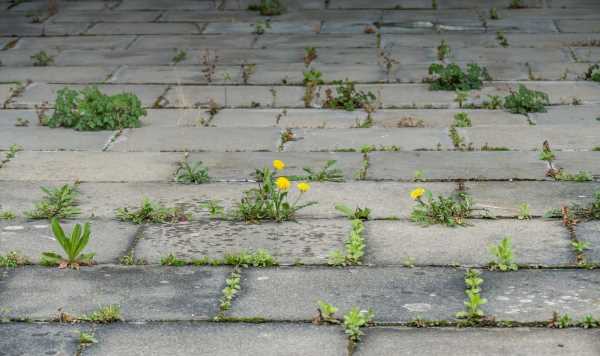Envirobond: How to remove weeds from your Paving stone joints
Patios and paving are sometimes deliberately planted with thymes or other low-growing plants to add interest. However, many unwelcome weeds find their way into drives and the cracks between paving. To tackle them without using harsh chemical weed killers, gardeners have taken to the Mrs Hinch Gardening Tips Facebook page to share a method that uses three household staple ingredients.
Georgina Mitchell wrote: “I have numerous weeds coming through my block paving. I’m fed up of weeding them all to be just as bad the next week. Any ideas please?”
Sometimes the cause of constant weed growth is simply down to the fact that the weeds gardeners are removing aren’t being removed properly.
Some come out easily by hand but others may leave bits of root behind and it’s these roots that allow weeds to keep coming back.
Other weeds spread seeds around the garden after they have been plucked from the ground.

For an effective natural method that is easier than removing paving weeds by hand, gardeners suggested Georgina create her own weed killer using salt, white vinegar and washing up liquid.
Kerry Atkinson said: “I use white vinegar, washing up liquid and salt. It works fab, swear by it.”
Jane Kent wrote: “Salt, vinegar, water and washing up liquid mixed and sprayed on the area.”
Stuart Jones commented: “One of the reasons weeds grow through block paving is because the silicone sand needs replacing.
Don’t miss…
‘Effective’ 29p kitchen item to remove toilet limescale without bleach [TIPS]
‘Revive’ your white towels with ‘simple cupboard solution’ [EXPERT]
‘Biggest mistakes’ to avoid when buying a property – ‘major setback’ [INSIGHT]
“I only use distilled white vinegar, table salt and washing up liquid mixed water to eradicate these problem weeds naturally.
“But once they are gone, brush in silicone sand right up to the level of the block paving this stops wind born weed seeds from entering to soil level through the blocks. You can get silicone sand from a good builders merchant.”
Karen Bowen said: “I use white vinegar, a good squirt of washing up liquid and a good amount of salt. Mixed together it forms a magical homemade weed killer spray. Put in a spray bottle and spray on the weeds this stops weeds coming back.”
Clare Jewell commented: “My old neighbour used to swear by salt to kill paving weeds. But I like to combine it with white vinegar and washing up liquid to make it more effective.”
![]()
Lisa Ralphs said: “I make a mix of white vinegar, salt and washing up liquid in a sprayer. Vinegar smells, but goes after 30 minutes. Kills weeds every time, cheap and easy. Used this for years (after spending so much on Weedol).”
Jack Sutcliffe, gardening expert at Power Sheds also recommended using this method to kill paving weeds. He said: “Get rid of unwanted weeds and any leftover crops to give it a cleaner look. A cheaper hack to help with this and save costs, is by making your own weed killer with a mixture of white vinegar, salt, and washing up liquid.”
This DIY homemade vinegar weed killer recipe kills any garden weeds or plants and may turn soil slightly acidic for a bit, which is why it is best to use it only for paving weeds. For best results apply on a dry day when the sun is shining, before midday.
How it works
White vinegar
The active ingredient in vinegar is acetic acid. Household vinegar has an acetic acid concentration of about five percent. Acetic acid is a desiccant, meaning that when sprayed on the surface of a plant, it draws moisture out of the leaves, killing the top growth.

Salt
Sodium chloride, or table salt, is also a desiccant. Salt is added to weed killer recipes because it is stronger, and kills some plants that vinegar won’t kill.
It negatively impacts the soil for a longer period of time than vinegar, and it may affect the roots of other nearby plants, as well. For this reason only use it on paving weeds.
Washing up liquid
Soap is a surfactant, meaning it increases the spread of vinegar and salt onto a weed’s leaves.
It also can increase the absorption of desiccants because it can break down the protective waxy surfaces of some leaves.
Source: Read Full Article
